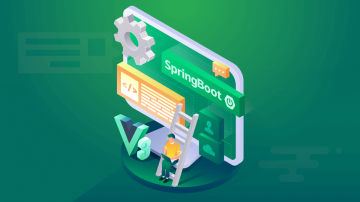本文介绍了如何使用Spring Boot 3进行开发,涵盖了新特性、环境设置、项目创建、核心配置以及实战案例。文章详细讲解了从入门到实战的全过程,帮助开发者快速上手并掌握Spring Boot 3的各项功能。此外,还提供了部署和监控方面的指导,确保应用能够顺利运行。
Spring Boot 3教程:入门与实践指南 Spring Boot 3简介Spring Boot 3新特性概述
Spring Boot 3是Spring Boot框架的最新版本,提供了许多新特性和改进,旨在简化开发过程并提高应用程序的健壮性。以下是Spring Boot 3的一些关键新特性:
- 更强大的依赖管理:Spring Boot 3使用Gradle作为默认构建工具,并提供了更强大的依赖管理功能。
- 改进的安全性:Spring Boot 3提供了增强的安全性功能,包括内置的身份验证和授权机制。这使得开发者可以更轻松地实现安全的Web应用程序。
- 支持Java 17:Spring Boot 3支持最新的Java版本,从而可以使用新的语言特性和库。这确保了应用程序能够获得更好的性能和兼容性。
- 改进的Web特性:Spring Boot 3改进了Web应用的构建和测试,提供了更灵活的配置选项。这使得开发者能够更高效地开发和测试Web应用程序。
- 支持Actuator 3:Actuator是Spring Boot中的一个模块,用于监控和管理应用程序。Spring Boot 3集成了Actuator 3,提供了更多的监控选项。
- 更新的Spring生态系统:Spring Boot 3与最新的Spring生态系统组件保持同步,包括Spring Data、Spring Security等。
设置开发环境
要开始使用Spring Boot 3,你需要安装以下工具:
- Java JDK:确保安装了Java 17及以上版本。
- IDE:推荐使用IntelliJ IDEA或Eclipse。以下是安装Eclipse的示例:
# 安装Eclipse sudo apt update sudo apt install eclipse - 构建工具:Spring Boot推荐使用Gradle作为构建工具,但你也可以选择使用Maven。
- Git:用于版本控制。
安装完成后,你可以使用以下命令检查Java版本:
java -version使用Spring Initializr创建项目
Spring Initializr是一个在线工具,可以用来快速生成Spring Boot项目。你可以访问Spring Initializr网站(https://start.spring.io/),按照以下步骤创建项目:
- 选择生成器:选择Maven或Gradle项目。
- 项目元数据:填写项目名称、包名、依赖管理等。
- 项目依赖:选择所需的依赖项,例如Spring Web、Spring Data JPA等。
- 下载项目:点击“Generate”按钮下载项目。
项目结构解析
创建项目后,你将得到一个基本的Spring Boot项目结构。以下是一个典型的项目结构:
src/
└── main/
├── java/
│ └── com/
│ └── example/
│ └── demo/
│ ├── DemoApplication.java
│ └── controller/
│ └── HelloController.java
└── resources/
├── application.properties
└── static/
└── index.htmlDemoApplication.java:这是Spring Boot应用程序的主入口点。HelloController.java:这是第一个控制器,定义了REST API。application.properties:这是Spring Boot的配置文件。static/:存放静态资源文件,如HTML、CSS和JavaScript文件。
以下是DemoApplication.java的一个示例:
package com.example.demo;
import org.springframework.boot.SpringApplication;
import org.springframework.boot.autoconfigure.SpringBootApplication;
@SpringBootApplication
public class DemoApplication {
public static void main(String[] args) {
SpringApplication.run(DemoApplication.class, args);
}
}以下是HelloController.java的一个示例:
package com.example.demo.controller;
import org.springframework.web.bind.annotation.GetMapping;
import org.springframework.web.bind.annotation.RestController;
@RestController
public class HelloController {
@GetMapping("/hello")
public String sayHello() {
return "Hello, World!";
}
}application.properties与application.yml配置详解
Spring Boot使用application.properties或application.yml文件来配置应用程序的各种属性。以下是一些常见的配置选项:
- 服务器配置:
server.port:指定服务器的监听端口。server.servlet.context-path:指定应用程序的上下文路径。
- 数据源配置:
spring.datasource.url:数据库连接URL。spring.datasource.username:数据库用户名。spring.datasource.password:数据库密码。
- JPA配置:
spring.jpa.hibernate.ddl-auto:数据库生成策略。
以下是application.properties的一个示例:
server.port=8080
spring.datasource.url=jdbc:mysql://localhost:3306/testdb
spring.datasource.username=root
spring.datasource.password=root
spring.jpa.hibernate.ddl-auto=update配置文件的外部化
Spring Boot允许将配置文件外部化,以便在不同的环境中使用不同的配置。你可以创建多个配置文件,例如application-dev.properties和application-prod.properties,并在运行时通过命令行参数指定激活哪个配置文件。
以下是如何通过命令行参数指定配置文件的示例:
java -jar demo-0.0.1-SNAPSHOT.jar --spring.profiles.active=dev创建控制器与RESTful接口
控制器是处理HTTP请求的组件。以下是如何创建一个简单的控制器来定义RESTful API:
- 创建一个控制器类,例如
HelloController.java。 - 在控制器类中定义处理HTTP请求的方法,例如GET、POST等。
以下是HelloController.java的一个示例:
package com.example.demo.controller;
import org.springframework.web.bind.annotation.GetMapping;
import org.springframework.web.bind.annotation.RestController;
@RestController
public class HelloController {
@GetMapping("/hello")
public String sayHello() {
return "Hello, World!";
}
}使用Spring Data JPA操作数据库
Spring Data JPA是一个用于简化数据库操作的框架。以下是使用Spring Data JPA操作数据库的步骤:
- 创建一个实体类。
- 创建一个JPA仓库接口。
- 在控制器中使用仓库接口来执行数据库操作。
以下是一个简单的示例:
实体类User.java:
package com.example.demo.model;
import javax.persistence.Entity;
import javax.persistence.GeneratedValue;
import javax.persistence.GenerationType;
import javax.persistence.Id;
@Entity
public class User {
@Id
@GeneratedValue(strategy = GenerationType.IDENTITY)
private Long id;
private String name;
private String email;
// Getters and Setters
}仓库接口UserRepository.java:
package com.example.demo.repository;
import com.example.demo.model.User;
import org.springframework.data.jpa.repository.JpaRepository;
public interface UserRepository extends JpaRepository<User, Long> {
}控制器UserController.java:
package com.example.demo.controller;
import com.example.demo.model.User;
import com.example.demo.repository.UserRepository;
import org.springframework.beans.factory.annotation.Autowired;
import org.springframework.web.bind.annotation.*;
import java.util.List;
@RestController
public class UserController {
@Autowired
private UserRepository userRepository;
@GetMapping("/users")
public List<User> getAllUsers() {
return userRepository.findAll();
}
@PostMapping("/users")
public User createUser(@RequestBody User user) {
return userRepository.save(user);
}
}使用Spring Security进行身份认证
Spring Security是一个强大的安全框架,可以用来保护Spring Boot应用程序。以下是如何使用Spring Security进行身份认证的步骤:
- 添加Spring Security依赖。
- 配置Spring Security以保护应用程序。
以下是DemoApplication.java的一个示例:
package com.example.demo;
import org.springframework.boot.SpringApplication;
import org.springframework.boot.autoconfigure.SpringBootApplication;
import org.springframework.security.config.annotation.web.configuration.EnableWebSecurity;
@SpringBootApplication
@EnableWebSecurity
public class DemoApplication {
public static void main(String[] args) {
SpringApplication.run(DemoApplication.class, args);
}
}安全配置类SecurityConfig.java:
package com.example.demo;
import org.springframework.context.annotation.Bean;
import org.springframework.security.config.annotation.web.builders.HttpSecurity;
import org.springframework.security.config.annotation.web.configuration.EnableWebSecurity;
import org.springframework.security.config.annotation.web.configuration.WebSecurityConfigurerAdapter;
import org.springframework.security.core.userdetails.User;
import org.springframework.security.core.userdetails.UserDetails;
import org.springframework.security.core.userdetails.UserDetailsService;
import org.springframework.security.provisioning.InMemoryUserDetailsManager;
@EnableWebSecurity
public class SecurityConfig extends WebSecurityConfigurerAdapter {
@Override
protected void configure(HttpSecurity http) throws Exception {
http
.authorizeRequests()
.antMatchers("/", "/home").permitAll()
.anyRequest().authenticated()
.and()
.formLogin()
.loginPage("/login")
.permitAll()
.and()
.logout()
.permitAll();
}
@Override
@Bean
public UserDetailsService userDetailsService() {
UserDetails user =
User.withDefaultPasswordEncoder()
.username("user")
.password("password")
.roles("USER")
.build();
return new InMemoryUserDetailsManager(user);
}
}集成前端框架(如Thymeleaf)
Spring Boot支持多种前端框架,例如Thymeleaf、Freemarker等。以下是使用Thymeleaf集成到Spring Boot中的步骤:
- 添加Thymeleaf依赖。
- 创建HTML模板文件。
- 在控制器中返回HTML模板。
以下是DemoApplication.java的一个示例:
package com.example.demo;
import org.springframework.boot.SpringApplication;
import org.springframework.boot.autoconfigure.SpringBootApplication;
@SpringBootApplication
public class DemoApplication {
public static void main(String[] args) {
SpringApplication.run(DemoApplication.class, args);
}
}控制器UserController.java:
package com.example.demo.controller;
import org.springframework.stereotype.Controller;
import org.springframework.web.bind.annotation.GetMapping;
@Controller
public class UserController {
@GetMapping("/")
public String index() {
return "index";
}
}HTML模板文件src/main/resources/templates/index.html:
<!DOCTYPE html>
<html xmlns:th="http://www.thymeleaf.org">
<head>
<title>Home</title>
</head>
<body>
<h1>Welcome to the Home Page</h1>
</body>
</html>应用打包与部署
Spring Boot应用程序可以打包成可执行的JAR或WAR文件,并部署到各种环境中,例如本地服务器、云平台等。
-
打包JAR文件:
使用命令mvn package或gradle build打包项目。mvn clean package - 部署到本地服务器:
使用Java命令运行打包好的JAR文件。java -jar target/demo-0.0.1-SNAPSHOT.jar
使用Actuator进行应用监控
Spring Boot Actuator提供了许多端点,可以用来监控和管理应用程序。以下是一些常用的端点:
/actuator/health:检查应用程序的健康状况。/actuator/metrics:获取应用程序的度量信息。/actuator/env:查看应用程序的环境属性。/actuator/configprops:查看应用程序的配置属性。
以下是启用Actuator的示例:
package com.example.demo;
import org.springframework.boot.SpringApplication;
import org.springframework.boot.autoconfigure.SpringBootApplication;
import org.springframework.boot.autoconfigure.web.reactive.error.DefaultErrorWebExceptionHandler;
import org.springframework.context.annotation.Bean;
import org.springframework.core.Ordered;
import org.springframework.web.reactive.function.server.RouterFunction;
import org.springframework.web.reactive.function.server.RouterFunctions;
import org.springframework.web.reactive.function.server.ServerResponse;
@SpringBootApplication
public class DemoApplication {
public static void main(String[] args) {
SpringApplication.run(DemoApplication.class, args);
}
@Bean
public RouterFunction<ServerResponse> notFound(DefaultErrorWebExceptionHandler exceptionHandler) {
return RouterFunctions.route()
.GET("/**", request -> ServerResponse.notFound().build())
.GET("/actuator/**", request -> ServerResponse.notFound().build())
.build()
.filter((request, next) -> next.handle(request)
.filter(result -> result.statusCode().is4xxClientError())
.switchIfEmpty(Mono.just(result -> result.statusCode(HttpStatus.NOT_FOUND)))
);
}
@Bean
public DefaultErrorWebExceptionHandler customErrorWebExceptionHandler(DefaultErrorWebExceptionHandler defaultErrorWebExceptionHandler) {
return new DefaultErrorWebExceptionHandler() {
@Override
protected RouterFunction<ServerResponse> getRoutingFunction(HandlerFunction<ServerResponse> function) {
return RouterFunctions.route(RequestPredicates.all(), function)
.filter((request, next) -> next.handle(request)
.filter(result -> result.statusCode().is4xxClientError())
.switchIfEmpty(Mono.just(result -> result.statusCode(HttpStatus.NOT_FOUND)))
);
}
};
}
}配置application.properties以启用Actuator端点:
management.endpoints.web.exposure.include=*
management.endpoint.health.show-details=always
management.endpoint.metrics.enable=true
management.endpoint.env.enable=true
management.endpoint.configprops.enable=true通过这些步骤和示例代码,你可以在真实的开发环境中创建、配置和部署一个Spring Boot 3应用程序。希望这个教程对你有所帮助!

 随时随地看视频
随时随地看视频




